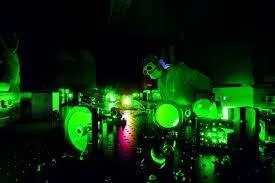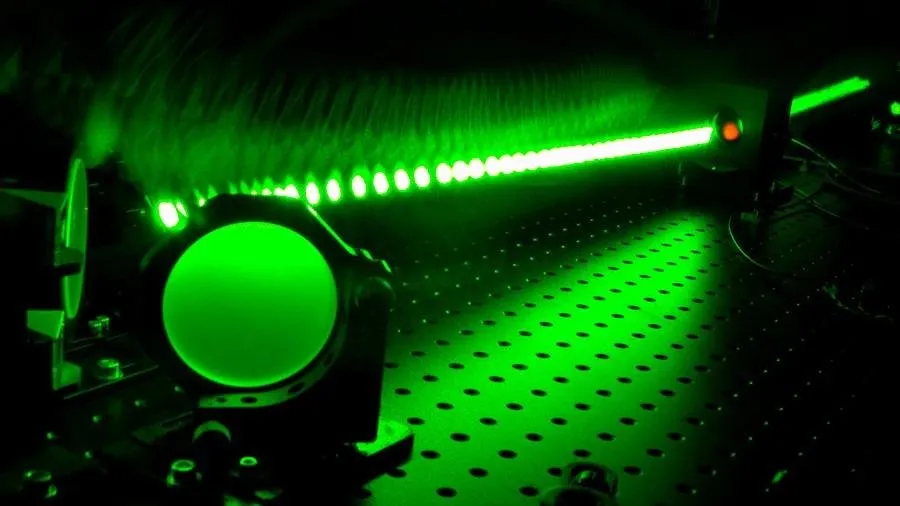Me parece un Artículo muy interesante!
Investigadores de la Universidad de Nebraska en Lincoln (UNL) han creado la luz más brillante jamás conseguida sobre la Tierra utilizando uno de los láseres más potentes, conocido como láser Diocles.
Este desarrollo ha logrado constatar inesperados cambios en la interacción entre la luz y la materia, según explican en un artículo publicado en la revista ‘Nature Photonics’.
Donald Umstadter y su equipo usaron el ‘Laser Diocles‘ sobre electrones suspendidos en helio para medir cómo los fotones del láser se dispersan después de esa interacción.
“Cuando tenemos esta luz brillante inimaginable, resulta que la dispersión -esa cosa fundamental que hace todo visible- cambia fundamentalmente su naturaleza“, explica Umstadter.
Demostrando que al alcanzar un nivel la extrema luminosidad del láser altera el ángulo, la forma y la longitud de onda de la luz diseminada por los fotones al golpear a los electrones.
“Es como si las cosas aparecieran diferentes a medida que aumenta el brillo de la luz”, algo que según Umstadter no es lo habitual, ya que un objeto “normalmente se vuelve más brillante, pero su apariencia es la misma que con un nivel más bajo de luz.”
El estudio por otro lado logra evidenciar o traer a la luz viejas hipótesis en el campo de la electrodinámica que los científicos no habían podido poner a prueba por limitaciones tecnológicas, ya que nunca habían tenido una fuente de luz tan luminosa para llevar a cabo los experimentos.
Estos rayos X podrían usarse también como una cámara ultrarrápida para capturar instantáneas de los movimientos de electrones o las reacciones químicas.
El Laboratorio de Luz Extrema es el hogar de Diocles. Sentado dentro de un espacio cuadrado de 15 por 15 pies, este láser pequeño pero potente produce tanta energía como 100.000 presas Hoover, todo dentro del marco temporal de 30 billonesimas de una millonésima de segundo, también conocido como 25 femtosegundos.
Diocles produce una presión mayor que la del núcleo del sol. Este proceso permite al director de laboratorio Donald Umstadter y su equipo estudiar las condiciones encontradas sólo en los horizontes de los agujeros negros o dentro de las supernovas explosivas. Los científicos de Nebraska están respondiendo a grandes preguntas científicas dentro del espacio de un pequeño laboratorio

Researchers at the University of Nebraska in Lincoln (UNL) have created the brightest light ever achieved on Earth using one of the most powerful lasers, known as the Diocles laser.
This development has been able to verify unexpected changes in the interaction between light and matter, as explained in an article published in the journal Nature Photonics.
Donald Umstadter and his team used the 'Laser Diocles' on electrons suspended in helium to measure how the laser photons are dispersed after that interaction.
"When we have this unimaginable bright light, it turns out that dispersion - that fundamental thing that makes everything visible - fundamentally changes its nature," explains Umstadter.
Demonstrating that by reaching a level the extreme luminosity of the laser alters the angle, shape and wavelength of light scattered by photons by striking electrons.
"It is as if things appear different as the brightness of light increases," something that Umstadter says is not usual, since an object "normally becomes brighter, but its appearance is the same as a more level Low light. "
The study on the other hand manages to bring to light or bring to light old hypotheses in the field of electrodynamics that scientists had not been able to test because of technological limitations, since they had never had such a light source to carry out the experiments .
These X-rays could also be used as an ultrafast camera to capture snapshots of electron movements or chemical reactions.
The Extreme Light Laboratory is the home of Diocles. Sitting within a 15-by-15-foot square space, this small but powerful laser produces as much energy as 100,000 Hoover dams, all within the 30-billionth frame of a millionth of a second, also known as 25 femtoseconds.
Diocles produces a higher pressure than the core of the sun. This process allows laboratory director Donald Umstadter and his team to study conditions found only in the horizons of black holes or inside explosive supernovae. Nebraska scientists are responding to large scientific questions within the space of a small laboratory



Fuentes:
http://www.noticias24.com/tecnologia/noticia/25945/desarrollan-luz-mil-millones-de-veces-mas-potente-que-la-del-sol/
http://www.unl.edu/physics/extreme-light-laboratory